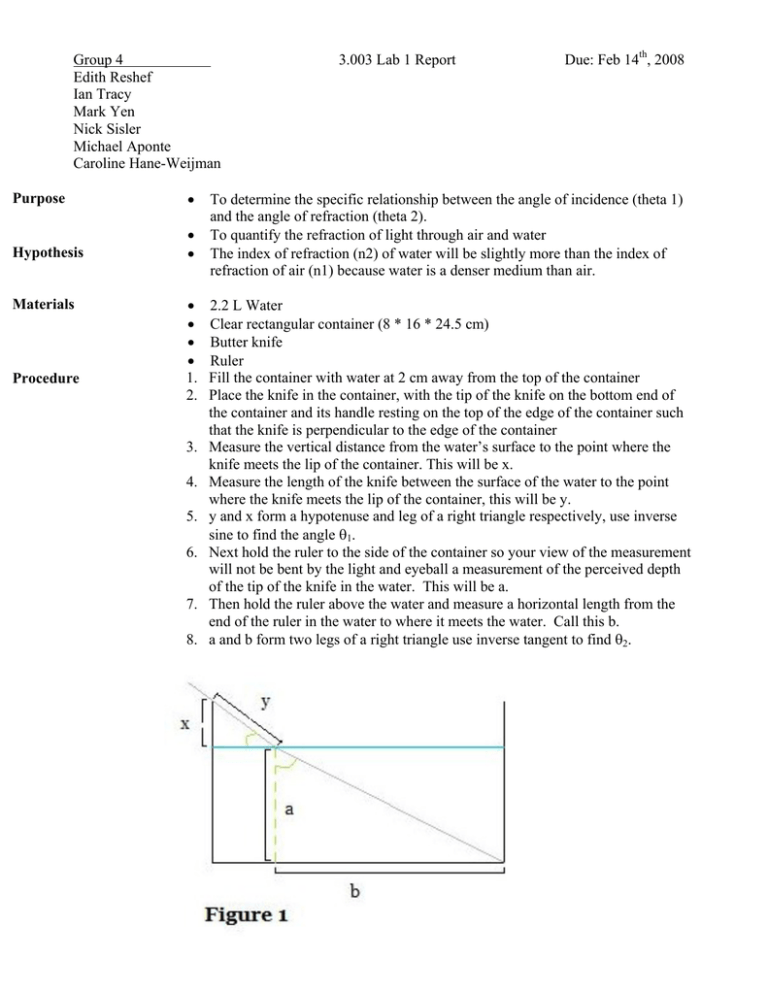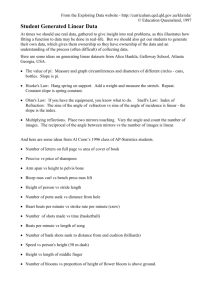Refractive Index
advertisement

Group 4 Edith Reshef Ian Tracy Mark Yen Nick Sisler Michael Aponte Caroline Hane-Weijman Purpose • Hypothesis • • Materials Procedure • • • • 1. 2. 3. 4. 5. 6. 7. 8. 3.003 Lab 1 Report Due: Feb 14th, 2008 To determine the specific relationship between the angle of incidence (theta 1) and the angle of refraction (theta 2). To quantify the refraction of light through air and water The index of refraction (n2) of water will be slightly more than the index of refraction of air (n1) because water is a denser medium than air. 2.2 L Water Clear rectangular container (8 * 16 * 24.5 cm) Butter knife Ruler Fill the container with water at 2 cm away from the top of the container Place the knife in the container, with the tip of the knife on the bottom end of the container and its handle resting on the top of the edge of the container such that the knife is perpendicular to the edge of the container Measure the vertical distance from the water’s surface to the point where the knife meets the lip of the container. This will be x. Measure the length of the knife between the surface of the water to the point where the knife meets the lip of the container, this will be y. y and x form a hypotenuse and leg of a right triangle respectively, use inverse sine to find the angle θ1. Next hold the ruler to the side of the container so your view of the measurement will not be bent by the light and eyeball a measurement of the perceived depth of the tip of the knife in the water. This will be a. Then hold the ruler above the water and measure a horizontal length from the end of the ruler in the water to where it meets the water. Call this b. a and b form two legs of a right triangle use inverse tangent to find θ2. Data The experiment was conducted by each group member one time and measurements were recorded and rounded as indicated on the table below. θ represents theta, so θ1 = theta 1, etc. To define variables: x1 represents the horizontal (along the surface of the water) distance between where the height of the rules was measured and the point at which it entered the water; x2 represents the horizontal distance between the point where the knife broke the surface of the water and where its end rested at the base of the container; y represents the hypotenuse of the triangle created by the knife above the surface of the water, aka the distance between its highest end and the point at which it breaks the water’s surface; z was the perceived depth of the end of the knife (vertical direction only) below the surface of the water; θ1 was the angle of reflection, formed by the slant of the knife above the water and the water’s surface (<90degrees); θ2 was the angle of refraction, formed by the slanted, submerged knife just below the surface of the water and the surface of the water (<90 degrees). Nick Ian Edith Mark Caroline n1 1 1 1 1 1 x1 (cm) 1.9 1.6 1.8 1.6 1.8 y (cm) 4.7 4.4 4.6 4.6 4.5 θ1 (degrees) 23.84 21.3 23 20.35 23.6 θ1 (radians) 0.416008 0.371685 0.40135 0.3551075 0.41182 sin(θ1) 0.4041 0.3632 0.3907 0.3477 0.4003 Average 1 1.74 4.56 22.418 0.3911941 0.3812 x2 3.7 2.9 2.7 2.9 3.2 3.0 8 Z (cm) 8.9 9.8 9.8 9.2 8.9 θ2 (deg.) 15.6 16.5 15.4 17.5 19.8 θ2 (rad.) 0.27222 0.28793 0.26873 0.30538 0.34551 sin(θ2) 0.2689 0.284 0.2655 0.3007 0.3387 n2 1.503 1.279 1.471 1.156 1.182 9.3 16.96 0.29595 0.2915 1.308 Arithmetic Mean of refraction index of water = Average n2 = 1.308 Percent Error from theoretical value (1.33) = | 1.308-1.33 | /(1.33) * 100 = 1.65 percent experimental error Deviation from theoretical value = (1.308-1.33)/(1.33) * 100 = -1.65 Here, the graph of a linear function passing through the origin of sine of theta 1 versus the sine of theta 2 of our experimental values yields a line with a slope of approximately our experimental arithmetic mean for n2: ~1.3, which has ~2.3 percent experimental error. continuation of Data For the critical angle θcritical, or critical angle with respect to the normal of the surface (water): what must be realized is that when light travels from a given medium into a more dense medium, the angle of refraction cannot be calculated by Snell’s law when the incident angle’s (θ2) sine value is greater than 1. At the point where the angle θ2 attains this value θcritical, θ1 will be 90 degrees (normal to the surface of the water) and light is reflected only within the denser medium, and is not reflected into the less dense medium. This phenomenon is known as internal reflection. So theoretically, at exactly θcritical, the ray of light does not yet internally reflect; it instead travels directly along the barrier between the two concerned mediums (the surface of the water in this experiment). sin(θ1)*n1 = sin(θ2)*n2 In order to calculate the critical angle for air and water, let θ1 = 90o and use Snell’s law to solve for θcrit: θcritical = sin-1(n1/n2) Which (theoretically) gives sin^-1 (1.0003/1.33) ~ 48.8 o When θ1 > θcritical, the light/incident ray is reflected only internally and thus no refraction is observed. Thus, if light is launched into the denser medium at angle θ1 exceeding 48.8 degrees, there should be no reflection from the surface of the denser medium. This can be confirmed logically in this case as follows: when θ2 = θcritical, simple algebra or inspection will prove that θ1 will be 90 degrees, and the light will be shined into the denser medium from a point normal to the surface of that denser medium (water). Experimentally, θcritical can be determined using this group’s set-up by adjusting the angle θ1 formed by the portion of the knife outside of the water and the surface of the water until it appears that the knife looks straight, as this marks the point when no light is reflected to cause a difference between a perceived and actual behavior of an object (the knife) in the denser medium. Conclusion This lab explored the relationship between the angle of incidence and the angle of reflection of an object placed in a tub of water. The goal of this was to determine the index of refraction for water, based on the known refraction for air (n = 1.003~1.0) and our perception of the angle of reflection. We placed a knife in a Tupperware container of water and measured (in centimeters) various heights and lengths of triangles that the knife formed with the container and the water (see figure 1) and then used trigonometry to figure out θ1 and θ2. With these two values, Snell’s law was then used to calculate the unknown index of refraction of water. Looking at the resulting data, the experimental value of the index of refraction of water was 1.308, a value higher than that of air. This experiment was controlled in that each observer measured every element of data in their trial. The measurement of the perceived height of the knife (a) was the experimental factor, differing slightly depending on the angle that each individual was looking at the tub from. This was accounted for by maintaining the same experiment conditions for all trials, placing the ruler in the same location and attempting to place each individuals eye level at the same location (same chair and relatively the same height). However, this accounted for most of the error made. When measuring a, the perceived depth, the ruler was held outside of the container so that the ruler measured accurately the perceived height as opposed to placing the ruler in the water which would have measured the accurate height. Again, this provided for error as this measurement was more difficult to take since the object that was being measured was at a distance away. The goal of this experiment was to quantify the refraction of light through air and water. Our resulting data supported our hypothesis that the index of refraction of water will be slightly greater than that of air since water is a denser medium, as we calculated the index of refraction of water to be 1.308, a value higher than the known index of 1.003 of air. Furthermore, it was determined that of θ1 exceeds θcritical~ 48.8 o total internal reflection occurs in n2, the denser medium. This means that no refracted ray appears, and no light is reflected from the denser medium back into n1 if θ1 attains or surpasses this angle. Consequently, as exemplified by optical fibers, all of the incident light will become trapped inside n2.


